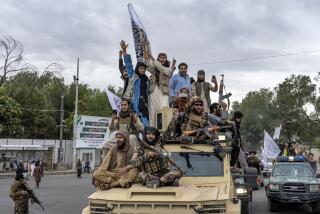U.N. Envoy to Afghanistan Fails to Halt Destruction of Statues
- Share via
UNITED NATIONS — A special U.N. envoy failed in a last-minute appeal to Afghanistan to save Buddhist sculptures and other art declared “un-Islamic” that the country’s ruling Taliban says should be destroyed by today.
Over the weekend, Taliban soldiers fired antiaircraft missiles at two giant Buddha statues carved in the sandstone cliffs in central Bamian province, shattering the figures’ heads and legs. Information and Culture Minister Qadratullah Jamal confirmed the damage and added that two-thirds of the country’s statues had been smashed.
“The statues are no big issue,” he told reporters in the capital, Kabul. “They are only objects made of mud or stone.”
Last week, Taliban leader Mullah Mohammed Omar declared that Islam forbids the worship of idols and that all religious statues had to be destroyed. His deadline for their elimination was Monday, the Muslim holy day of Eid al-Adha.
A special envoy from the United Nations’ Educational, Scientific and Cultural Organization flew from Paris to try to persuade the Taliban’s leaders to save the Bamian Buddhas, carved in the 3rd and 5th centuries and standing 175 and 120 feet tall, as well as some of the country’s other pre-Islamic treasures.
“I can’t say that my mission was successful,” said the envoy, Pierre Lafrance, after meeting Sunday with Mullah Omar. “I could not get the suspension of the order.”
He confirmed that the Taliban had destroyed small statues in the museums of three towns. The Taliban did not show him any other artworks.
Lafrance, a founder of a group focusing on preservation of Afghanistan’s heritage, remained cautiously optimistic that some of the art could be preserved.
“All doors are not closed,” he said. The order could still be softened, and religious leaders in Afghanistan were starting new consultations, he said.
He traveled to Pakistan after meeting with Mullah Omar but said in a U.N. statement that he would return to Afghanistan for more meetings Wednesday.
Other Muslim leaders disagree with the Taliban’s interpretation of the Koran, saying it merely forbids the worship of idols, not their existence. Some fear that Afghanistan’s actions will tarnish the image of Islam. The Arab League condemned the order last week as “a savage act.”
Afghanistan is a cultural crossroads for three great early civilizations--Greek, Indian and Central Asian--during which monks traveled with merchants to spread their religious beliefs. The Bamian statues are valuable not only because they may be the oldest and largest Buddhas that inspired those in China and Japan but also because of the way they embody the combination of cultures. Their faces are lightly smiling Buddhas, while their garments resemble Roman-Hellenic tunics.
The Taliban order has sparked worldwide condemnation.
Last week, the director of New York’s Metropolitan Museum of Art offered to purchase and preserve some of the endangered works.
“Aside from the rhetoric that they are a great spiritual testament, and vestiges of some of the great moments of mankind, if you want to get practical about it, the Taliban are desperate to build their economy,” said Philippe de Montebello, the museum’s director.
“One solution is tourism, but there will be nothing left for people to come see.”
The governments of Greece and India have also offered to buy and move the works, but all offers have been rebuffed. German Culture Minister Julian Nida-Ruemelin said the demolition echoed the Nazis’ mass burning of books in 1933.
In Afghanistan, this is not the first time that statues have been at risk. Museums were looted and destroyed by Soviet forces in the 1980s and during the civil war that followed the Soviets’ departure in 1989.
Until 1998, one of the factions fighting the Taliban stored its ammunition in caves adorned with ancient murals, so the Buddhas were in effect standing on a cache of explosives.
In 1999, Mullah Omar warned that the religious artworks should be preserved for tourism, but in the past few months, religious rigidity has resurfaced.
At a time when the Afghan people are suffering from a harsh drought and a bitter winter, the Taliban’s defiance may come with a heavy price.
The Japanese government warned that it might cut off aid to Afghanistan. In January, the U.N. imposed sanctions on Kabul for continued human rights abuses and harboring suspected terrorist Osama bin Laden, just after the Taliban had agreed to stop poppy cultivation and drug trafficking. Angry leaders said they were punished rather than rewarded for their cooperation, and they disparaged cooperation with the West.
Despite the country’s needs, the U.N. has raised only $14 million of an appeal for $229 million in humanitarian aid this year, less than the combined offers of museums and governments to save the country’s statues.
A State Department spokesman deplored the destruction on Monday but said the U.S. worries most about the peril to Afghans from fighting, drought and human rights abuses and will continue its humanitarian aid.
“While we’re concerned about statues, we’ve also been very concerned about the deepening plight of the Afghan people. They are facing an unprecedented humanitarian crisis for which the Taliban are largely responsible,” spokesman Richard Boucher said.
For the past two years, he said, the U.S. has been Afghanistan’s largest donor and provided $113 million in aid in fiscal 2000.
Farley reported from the United Nations and Wright from Washington.
More to Read
Sign up for Essential California
The most important California stories and recommendations in your inbox every morning.
You may occasionally receive promotional content from the Los Angeles Times.













